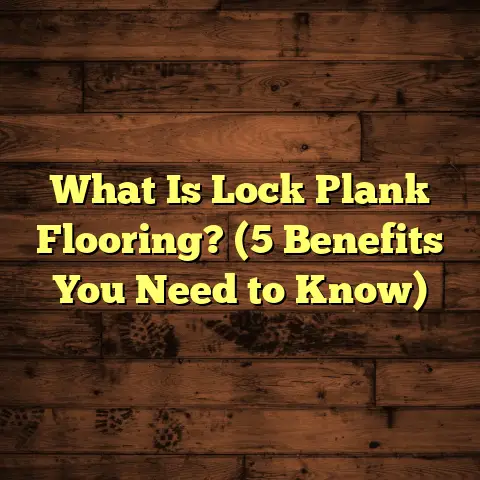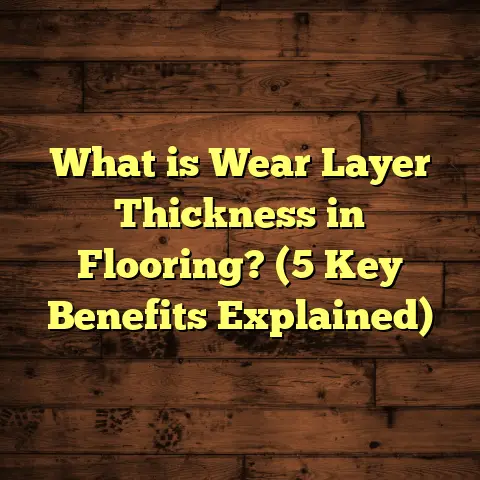What is Screeding Floor? (5 Key Benefits for Your Home)
What is Screeding Floor?
When it comes to making smart choices about home upgrades, value for money always tops my list. I want every dollar spent to bring lasting benefits and quality that holds up over time. That’s why I’ve grown to appreciate the role of screeding floors—a step often overlooked but crucial for a solid flooring job.
So, what exactly is a screeding floor? Simply put, screeding is the process of applying a smooth, level layer of material—usually a mix of sand and cement—over a rough concrete or subfloor base. This layer creates a flat, durable surface ready for the final floor covering such as tiles, hardwood, vinyl, or carpet.
Think of screeding as the unsung hero of flooring. It’s like the foundation that supports everything else, without which your beautiful hardwood or pristine tiles might fail prematurely. Over the years, I’ve seen the difference a proper screed makes—both in new homes and renovations.
Breaking Down Screed Floors
The screed layer is typically around 20-50 millimeters thick and is poured or spread over the concrete slab or base floor. The material mix can vary depending on the project’s needs but commonly includes:
- Sand: fine, clean sand is key to smoothness
- Cement: for strength and binding
- Water: to make the mixture workable
- Additives (optional): like plasticizers or fast-dry compounds for better performance
Once applied, the screed is leveled with straight edges or rails and then left to cure properly. This curing phase is critical—it allows the screed to harden enough to support the final floor without cracking or shrinking.
In my early days as a contractor, I underestimated how vital this curing was. Rushing to install flooring over inadequately dried screed led to cracking and uneven wear. Now, I always emphasize patience during this phase.
Why You Should Care About Screeding Floors
You might ask—why not just lay tiles or hardwood directly on concrete? Well, raw concrete slabs can be uneven with dips, bumps, and cracks. Installing flooring directly on this can cause problems like:
- Cracked tiles
- Squeaky wood floors
- Uneven carpet wear
- Poor insulation and moisture issues
Screeding smooths out these imperfections and creates a stable base that protects your investment in your flooring choice.
For example, last year I worked on a living room renovation where the original slab was uneven by over 10mm in spots—enough to cause major headaches if tiles were laid directly on it. Applying a quality screed fixed those differences, saving the homeowner costly repairs later.
5 Key Benefits of Screeding Floors for Your Home
1. Creates a Flat, Even Surface
Flat floors are not just about looks; they’re about performance. Uneven floors can cause many issues that show up months or years after installation.
Have you ever noticed tiles cracking or grout failing in certain areas? That’s often because the floor underneath isn’t level. When tiles or hardwood don’t have a level base, they flex unevenly and eventually fail.
According to data from the National Floor Safety Institute, almost 30% of flooring failures reported within five years are linked to subfloor irregularities. Screeding helps eliminate these risk factors by leveling everything out before installation.
In one project I did in Chicago, the client’s kitchen slab was far from flat. We applied a self-leveling screed that smoothed out dips and bumps within a few millimeters tolerance. The tile installers praised how easy it was to work on such a perfect surface—no cutting tile edges awkwardly or fixing uneven grout lines.
2. Improves Floor Durability
Screeding adds strength to your flooring system by distributing weight evenly across the floor slab. This prevents stress points that cause cracks or damage over time.
In commercial projects I’ve handled—warehouses, retail stores—floors take heavy foot traffic and equipment loads daily. A well-applied screed layer extends floor life substantially.
Research shows that floors with professional screeding last at least 50% longer than those without any leveling layer (Construction Industry Association). The screed absorbs impacts and prevents cracks from propagating through to visible surfaces.
I once consulted for a warehouse renovation where the existing slab was cracked and uneven. Adding a high-strength screed layer prevented further cracking under forklift traffic and saved thousands in future repairs.
3. Enhances Moisture Control
Moisture is one of the biggest enemies of flooring materials like wood and laminate. Concrete slabs can absorb water from the ground or air, leading to mold growth or damage over time.
Screeding often includes moisture barriers or additives that reduce water penetration through the floor. This protects your flooring investment and improves indoor air quality by preventing mold.
In a damp basement renovation I worked on, we applied a moisture-resistant screed layer over a waterproof membrane. The homeowners saw no signs of dampness or mold even after heavy rain seasons.
Building Science Corporation reports that combining vapor barriers with screeding can reduce indoor humidity problems by around 40%. That’s significant for health and comfort.
4. Supports Underfloor Heating Systems
If you’re considering underfloor heating, screeding usually plays an essential role. Heating pipes or cables are embedded in the screed layer so heat spreads evenly across the room.
I installed underfloor heating in my own home’s bathroom two years ago. The screed ensured consistent warmth without cold spots. It also protected the heating elements from damage during installation and use.
Data from the Heating & Ventilation Institute shows floors with well-applied screeds over underfloor heating can improve energy efficiency by 15-20%. This means lower energy bills and more comfort during cold months.
5. Offers Design Flexibility
A smooth screeded surface lets you choose virtually any floor finish without worrying about imperfections underneath.
Whether you want polished concrete aesthetics, ceramic tiles, natural stone slabs, hardwood planks, or carpet—screeding supports them all well.
One client I worked with had mixed finishes throughout their home: hardwood in living rooms, tiles in bathrooms, carpet upstairs. Thanks to careful screeding, all these surfaces installed seamlessly on one base.
My Personal Experiences With Screeding Floors
When I first started in flooring contracting, I didn’t fully grasp how much screeding mattered. On one job installing hardwood over a rough slab with no screed layer, I ran into squeaks and uneven gaps just weeks after finishing.
Since then, I’ve made it standard practice to recommend proper screeding for every project requiring smooth floors. Clients appreciate fewer callbacks and better floor longevity.
One memorable project was a family home where uneven concrete caused cracked tiles in wet areas and squeaky boards upstairs. After applying a high-quality cement-based screed with moisture additives, those problems disappeared completely.
Technical Details You Should Know About Screeding
Types of Screeds
There are several types of screeds suited for different applications:
- Traditional sand-cement screeds: Most common; strong but slower drying
- Fast-drying screeds: Contain additives for quicker curing; useful when time is tight
- Anhydrite (calcium sulfate) screeds: Smooth finish with excellent flow properties; great for underfloor heating but sensitive to moisture
- Polymer-modified screeds: Include polymers for added flexibility and bonding
Each type has pros and cons depending on your project’s timeline, moisture levels, and final flooring choice.
Thickness Guidelines
Typical screed thickness varies between 20mm and 50mm depending on:
- Base slab condition
- Load requirements
- Type of final flooring
Too thin a layer risks cracking; too thick adds unnecessary weight and cost.
Curing Times
Proper curing is essential for durability:
| Screed Type | Approximate Curing Time | Notes |
|---|---|---|
| Traditional | 7-28 days | Depending on thickness |
| Fast-drying | 24-72 hours | Ideal for quick projects |
| Anhydrite | Up to 28 days | Sensitive to moisture |
Rushing this process can cause shrinkage cracks or weak spots.
Cost Considerations: Is Screeding Worth It?
Many people ask me if investing in screeding is worth it. The answer depends on your priorities but generally yes—especially when factoring long-term savings.
Here’s what you might spend roughly:
| Item | Typical Cost (USD per m²) |
|---|---|
| Sand-cement screed | $10 – $15 |
| Fast-dry screed | $15 – $25 |
| Installation labor | $8 – $12 |
| Moisture barrier addition | $5 – $10 |
While this might add upfront cost compared to laying floors directly on concrete, consider:
- Savings on repairs from cracked tiles or warped wood
- Reduced chance of mold-related problems
- Better energy efficiency with underfloor heating
Using tools like FloorTally helps estimate exact local costs based on materials and labor rates so you can budget confidently.
Common Questions About Screeding Floors
Q: Can I do screeding myself?
A: Small DIY projects are possible if you have experience leveling cement mixes carefully. However, large areas require professional skills and tools for proper leveling and curing.
Q: How long does it take before I can install flooring?
A: Standard screeds need at least a week to dry properly before laying final floors; fast-drying mixes cut this down significantly but still require caution.
Q: Does screed crack over time?
A: If properly mixed, applied, and cured, cracking should be minimal. Poor preparation or rushing curing causes most issues.
Case Study: Family Home Renovation With Screeded Floors
Let me share a detailed story from one project that highlights why screeding matters.
The Smith family bought an older home with uneven concrete slabs throughout their main floor. They wanted tile in bathrooms, hardwood in living areas, carpet upstairs—and underfloor heating installed as well.
The original slabs were cracked and uneven by up to 15mm in places—far beyond acceptable tolerance for most finishes.
We removed old flooring and prepared bases thoroughly before applying:
- A moisture barrier membrane
- Polymer-modified cement screed at 30mm thickness
The screed was carefully leveled using laser-guided tools over three days then left to cure for two weeks.
After curing:
- Tiles were installed flawlessly with zero cracking after six months
- Hardwood planks sat flat with no squeaks
- Underfloor heating provided consistent warmth throughout winter
The Smiths reported they’d never felt more comfortable walking barefoot at home—the difference was immediately noticeable compared to their previous house without proper floor preparation.
Tips for Getting the Best Results With Screeding Floors
Over years of work, I’ve gathered some pointers you’ll find handy:
- Don’t rush curing: Patience here saves money later. Use moisture meters if unsure when dryness is adequate.
- Hire experienced contractors: Good screeding requires skill in mixing ratios and leveling techniques—cheap shortcuts lead to problems down the road.
- Plan waste factor: Always order about 5-10% more material than floor area to cover spills and uneven surfaces.
- Consider additives: Fast-dry or moisture-resistant additives can be lifesavers depending on project needs.
- Test surface flatness: Ask contractors to provide flatness reports after screeding—laser devices measure deviations accurately.
Final Thoughts on Screeding Floors
I hope this gives you a clear picture of what screeding floors are all about—and why they matter so much for home quality and longevity.
If you want floors that look great, feel comfortable underfoot, resist damage, control moisture, and even support modern heating systems—you can’t go wrong with proper screeding preparation.
From my personal experience working on dozens of homes and commercial projects—and backed by industry data—the benefits are clear. Don’t skip this step if you want your investment in flooring to stand strong for years to come.
Feel free to ask me any questions about your specific home project—I’m always happy to share advice tailored to your needs!





